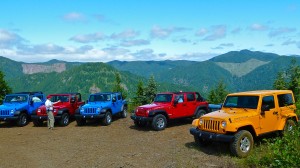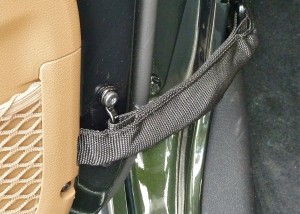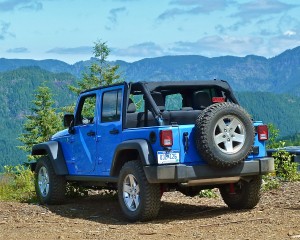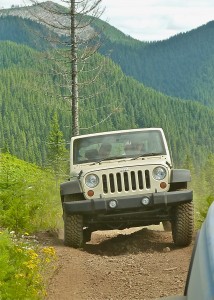New Wrangler both smooth and rugged
By John Gilbert
The transformation of all the new Chrysler Brand vehicles under Fiat ownership has been both subtle and startling. New styling flair to the interiors on everything from Dodge and Chrysler minivans to sedans and to sporty cars is evident, and for 2012, Fiat’s fine hand is reaching down for arguably its greatest achievement. The rugged Jeep Wrangler , which has been a rock-climbing dynamo since it originated for use in World War II, retains that status, but  for 2012, it has magically become a smooth and impressive performer on the road, too.
How ironic that it took an Italian company to convince Jeep engineers that World War II has, indeed, ended.
Back in 1940, Willys-Overland won the bid to build the first military Jeeps for the U.S. Army, and while it was sturdy and totally efficient enough to serve as the military’s rugged “sports car†alongside the tanks and troop trucks, it also was properly primitive, and clearly was for work, not comfort.
Almost an emblem of the Jeep’s simple features was a small strap, tethered to the lower frame inside the doorjamb, and looping around a small vertical bar on the lower door. The door could be thrown open, but that strap prevented it from opening too far.
Jeep migrated through owners, including American Motors, and finally Chrysler Corporation over the next 70 years, and much of its charm was that it stayed primitive and efficient, and if the off-road-tuned suspension harshness wasn’t convincing enough, there was always that little strap remaining in place, upgraded to tightly braided ballistic nylon cord in more modern times, and reminding its owners that it still remained true to its World War II heritage.
Other Jeep vehicles came out, modernized to the times, such as the Cherokee, Compass, Liberty, and the Patriot, and while they were softened to various degrees of on-road demands, the Wrangler stayed rugged and purpose-built, and, well…primitive. The Wrangler models did take a major step forward in interior design and connectivity features for the 2011 model year, when new owner Fiat gave all Chrysler Brand products a thorough and pleasant makeover.
The primary feature of Wranglers continued on the 2011 models, however, with their no-nonsense, off-road ruggedness, free of fancy features, which also meant they were pretty free of anything resembling on-road comfort as well. Wranglers remained at home climbing rock walls, but their unyielding suspension rigidity also meant that actually driving home on real roads was a lot like taking a 10-mile cruise on a pogo stick.
The transformation takes a giant step on the 2012 Wranglers, introduced to the automotive media in Portland, Ore., in August. Still unmatched off the road, the new Wrangler is remarkably smooth and composed on the roads, too.
We were braced for an itinerary leading us out of the city on freeways, turning off on twistier mountain roads, and ending up in the Tillamook Forest. Once there, we could drive off-road, along spectacular rockbound ridgelines where one false move would cause you to tumble to depths better measured in minutes than distance.

All eight models of the Wrangler and Wrangler Unlimited responded to test-drives on and off roadways.
Among the most substantial improvements to the new Wrangler is the insertion of Chrysler’s impressive new Pentastar V6, a 3.6-liter jewel that replaced seven decidedly mediocre V6 engines in Chrysler’s supply line — including the 3.8-liter V6 that only recently had been fitted under the hood of Wranglers. The new 3.6 was voted to the prestigious Ward’s Top 10 Engines list for 2011.
All Wranglers get the 3.6, with no alternatives. That means even if they beg, Wrangler buyers will be forced to accept more power, more towing capacity, and better fuel economy. Not a bad compromise. Chrysler’s catch-phrase is: “New heart; same soul.â€
The heart is the smaller-displacement 3.6, with its aluminum block, dual-overhead camshafts and variable valve-timing, and it’s also the only engine available in the Dodge and Chrysler minivans, as well as the base engine in the Grand Cherokee and the mainstay of all the sedans. It is 33 pounds lighter than the iron-block 3.8, and its 285 horsepower is 40 percent more than the 202 horses of the 3.8, and its 260 foot-pounds of torque is a 10-percent increase over the 237 of the larger 3.8. The power increase covers the best of both worlds — its 8.4-second 0-60 time is a 2-second improvement, and the towing maximum has been increased to 3,500 pounds.
In addition, the Wrangler gets a new 5-speed automatic transmission, compared to the previous 4-speed. Having an extra gear makes the new engine greatly improved in flexibility and in staying close to the power peak, benefits for both on- and off-roading. Wrangler also becomes the first vehicle to offer a 6-speed manual transmission hooked up to the Pentastar V6. We drove both, and the stick makes the Wrangler perform like a thoroughly enjoyable sporty vehicle on the road, which made our off-road tests a definite requirement, just to prove it hadn’t lost anything in the compromise.
Wranglers come in two-door and four-door models, with a fixed or removable hardtop, or a convertible fabric roof. The four-door has a longer wheelbase, to encompass the greater interior room, which gives the two-door a smaller turning radius and more off-road agility. The four-door, however, has a smoother on-road ride with the longer wheelbase. My favorite is the four-door with the convertible top, because the top can be opened at the very rear, behind the two rows of seats, or open over all the seats. It is a sporty, user-friendly vehicle.
Things like automatic temperature control, heated seats, power mirrors, and Bluetooth connectivity, with remote controls on the steering wheel, are features you might not have anticipated ever finding on a Jeep Wrangler.
The Wrangler and the Wrangler Unlimited are available in four models — Sport, Sport S, Sahara, and Rubicon. All four can be bought in either two-Â or four-door versions. The Wrangler Sport base price is $22,045, the Sport S is $24,245, the Sahara $27,970, and the Rubicon $29,995. The Wrangler Unlimited starts with the Sport, which has a base price of $25,545, the Sport S at $27,745, Sahara at $30,745, and the Rubicon $33,570.
With the new engine and transmission offering plenty of power on highways, our Wrangler test vehicle had standard electronic stability control, electronic roll mitigation, trailer sway control, brake traction control, and hill-start assist, which, with the manual transmission, holds the brake pressure for a couple of seconds for a smoothly coordinated clutch release.
Such smoothness and the pleasant, quiet interior amenities make the new Wrangler outstanding on the highways and roadways, overcoming that traditional old primitive World War II feeling of previous Wranglers. It’s almost like a less-expensive, and considerably cheaper, alternative to the Grand Cherokee.
The Wrangler loses none of its ruggedness or capability by suddenly becoming smooth and comfortable on the road. Naturally, all that power means some serious punch when scaling rocky-top mountains or any rugged terrain, and we did plenty of that, putting to hardy tests the three key elements of off-roading — 10.6-inch ground clearance, a 44.6-degree approach angle, and a 40.6-degree departure angle.
The less-aggressive Sport and Sahara models of the Wrangler have a Dana 30 front axle and a Dana 44 rear axle, with Command-Trac part-time two-speed transfer case. The more serious off-roading Rubicon models have heavier-duty Dana 44 front and rear, with a Rock-Trac two-speed transfer case, electric front and rear locking differentials, and disconnectable front stabilizer bar.
When we did the most rugged off-roading, we did it in a chain of a half-dozen Wranglers along a specially tailored ridgeline obstacle trail in the Tilamook Forest, and I happened to be first in line behind the off-road driving instructor leading the group. The most impressive part of our trek was when the lead Wrangler would climb through such rugged terrain that the right front wheel might be canted 10 degrees to the right, while the right rear might be canted 10 degrees to the left — at the same moment — while the Wrangler itself remained in a flat attitude.
I drove the automatic on those extremely steep inclines, although I wondered if the manual might put the Hill-Assist to work. If so, you’d want to be plenty quick to engage the clutch promptly, because if it released too soon, you could be in for a sudden back-up maneuver when you wanted it least.
Apparently I’m not the only one who likes the longer-wheelbase, four-door model. Chris Ellis, Jeep marketing manager, said: “We thought the four-door would be a niche vehicle, and could make Wrangler more of an everyday family vehicle, but so far our sales are up 43 percent, year-over-year, and we’re selling 60 percent four-doors.
“It’s much-improved on the road, but we haven’t compromised anything. You can still take the doors off, fold the windshield down, and hose out the interior.â€

Braided nylon strap still keeps the door tethered, 70 years later, and it now shields power window and lock wiring.
For 2012, you can have your off-road superstar and now get it with all the safety and comfort goodies, plus features such as Bluetooth streaming audio, and SiriusXM satellite radio with Travel Link, which means you can scale that rocky peak while catching weather forecasts, regional fuel prices, sports scores, and movie listings. And yes, that little braided nylon strap still connects the lower door sill to the door just as it connects the 2012 Wrangler to the 1940 Jeep. The difference is it now includes wiring inside it to operate power windows and door locks.
Comments
Tell me what you're thinking...
and oh, if you want a pic to show with your comment, go get a gravatar!




 John Gilbert is a lifetime Minnesotan and career journalist, specializing in cars and sports during and since spending 30 years at the Minneapolis Tribune, now the Star Tribune. More recently, he has continued translating the high-tech world of autos and sharing his passionate insights as a freelance writer/photographer/broadcaster. A member of the prestigious North American Car and Truck of the Year jury since 1993. John can be heard Monday-Friday from 9-11am on 610 KDAL(www.kdal610.com) on the "John Gilbert Show," and writes a column in the Duluth Reader.
John Gilbert is a lifetime Minnesotan and career journalist, specializing in cars and sports during and since spending 30 years at the Minneapolis Tribune, now the Star Tribune. More recently, he has continued translating the high-tech world of autos and sharing his passionate insights as a freelance writer/photographer/broadcaster. A member of the prestigious North American Car and Truck of the Year jury since 1993. John can be heard Monday-Friday from 9-11am on 610 KDAL(www.kdal610.com) on the "John Gilbert Show," and writes a column in the Duluth Reader.